E-Archive
Cover Page
in Vol. 5 - March Issue - Year 2004
Environmentally Safe, UV Curable Masking Resins
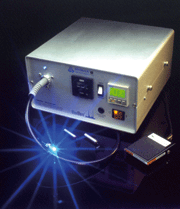
200 Watt Spot Lampwith Single Pole Lightguide
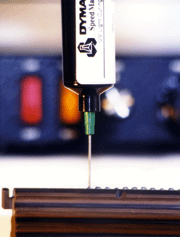
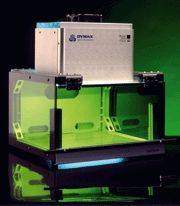
Flood Lamp with Enclosure
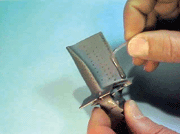
Removal of a Peelable Masking Resin
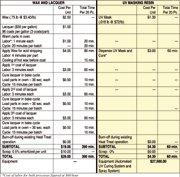
An alternative to Solvent Based Lacquers
In today’s environment, process cost reductions have taken on a greater meaning: Survival. Competitive pressures in the market are forcing manufacturers to evaluate every aspect of their processes for cost reduction opportunities while still improving the workplace environment. The process of masking prior to any surface finishing operation may seem simple enough, yet it can add significant cost, and decrease throughput to the simplest of surface finishing operations. The more complex and intricate a component, the longer it takes to apply and remove traditional masks such as tapes, waxes and solvent based lacquers. Masking of components and surfaces is a necessary part of every surface finishing process. Whether for grinding, abrasive cleaning, such as grit blast or vibratory finishing, acid stripping, shot peening, anodizing, chemical milling, plasma spray, or plating, masks act as a self-sacrificing barrier for surface protection. These costs may not be readily visible, as the masking material is typically not the major contributing element to cost. Rather, it is the masking process itself, specifically the labor to apply and remove the masking, which can be the major cost factor. There are other hidden costs associated with using these masks. They can include scrap, component rework, production bottlenecks, specialized ventilation, floor space allocated to drying areas, workman’s compensation claims, hazardous waste disposal costs and higher insurance premiums. When the cost of labor is factored in with the other hidden costs, it becomes apparent that simply using a lower priced masking material will not provide the desired cost savings that are required for greater competitiveness in the market.
When traditional paths cannot offer tangible savings opportunities, the door must be opened to new technology. Such technology is now available with UV Curable Masking Resins. Significant contributions include:
-Increased Through-put
-Worker and Environmentally Friendly
-Minimal Capital Investment
-Easily Integrated into Automated Production
UV Curable Masking Resins have proven to provide cost reductions in the current turbine (aerospace and power generation), metal finishing and surface finishing industries. The ability to apply a UV maskant and cure it instantly facilitates uninterrupted component processing. For ease of use, UV Masking Resins offer several viscosity variations, from the consistency of water to non-flowing gels. This permits controlled coverage, including coating depth, in a single application. UV Curable Masking Resins are easily dispensed, both in manual and in fully automated processing lines. Conventional, labor-intensive masking can be replaced with semi-automated or automated systems that provide controlled spraying, dipping, or precision placement of the UV curable, liquid masking resin. The superior adhesion and exceptional resiliency of UV Curable Masking Resins can also improve component quality by reducing post-processing rework and scrap, arising from deficiencies in traditional masking methods and products. The durability of UV Curable Masks makes it possible to mask only once for multiple surface processing operations, eliminating stripping and remasking between processes. Simply stated, this increased efficiency leads to lower costs.
The New Masking Option: UV Curable Masking Technology
Worker friendly and OSHA compliant, UV Curable Masks are solvent-free, low odor, non-flammable, liquid resins that cure in seconds upon exposure to ultraviolet light energy. They are specifically formulated to have no effect on the metallurgy of the surface being masked. These resins are urethane based, and contain no heavy metals, silica, or other compounds, which can alter properties of the component surface or the finish being applied. Once cured, these resins can be handled like any industrial plastic. When removed by recommended methods, UV Curable Masking Resins leave no residue behind. While some may be simple formulations and others more complex, UV masking resins are typically comprised of five basic elements: Photoinitiators, Additives, Monomers, Modifiers, Oligomers.
How Do UV Curable Masks Work?
The UV light curing process begins when the photoinitiator in the mask is exposed to a UV light energy source of the proper spectral output. Its molecules split into free radicals (initiation), which then begin to form polymer chains with the monomers, oligomers, and other ingredients (propagation), until all of the ingredients have formed a solid polymer (termination). What was once a liquid, is now a solid resin.
UV Curing Systems
Critical to the UV mask curing process is an ultraviolet light energy source. Several types of UV curing lamps and systems are commercially available. Spectral output of the lamp, intensity, component configuration, desired production throughput, and budget are all factors that help determine which type of UV curing system is appropriate. UV lamps may be grouped into two very broad categories, spot lamps and flood lamps. UV spot lamps generate high intensity UV energy that is directed through a fiber or liquid filled light guide, typically 5-8 mm in diameter. (Figure 1). These units are ideal for curing UV Masking Resins in cooling holes or sealing off core cavities. For larger surfaces flood lamps can be used which create light footprints up to 8” square.
UV Masking Resins
There are three basic grades of UV masking resins. They can be grouped by their removal mechanism: burn-off, peelable, or water-soluble.
Burn-Off Masking Resins
This grade offers the best surface adhesion and provides the greatest resistance to heat and aggressive chemical solutions such as acid/alkali baths. Some burn-off grades also offer a secondary heat curing capability for masking areas where UV light cannot penetrate, such as core cavity sealing to protect from debris, plating baths, and laser burn-through during drilling operations. Surface curing with UV light may take 20-30 seconds under a flood lamp, while heat curing may require 30-45 minutes in a 300o F oven.
Peelable Masking Resins
Peelable grades are the most versatile of UV Masking Resins, which provide good adhesion to most clean, metal surfaces, are resilient enough to withstand a variety of surface treatment processes, and can be removed through a simple peeling process. Cured in a few seconds with UV light, peelable masks have been successfully qualified for surface protection in processes such as grit blasting, shot peening, acid cleaning, plating and anodized coatings. The surface bond is very strong and durable, possessing sufficient adhesion to survive through multiple surface cleaning and processing operations, eliminating the need to strip and remask between processes. Peelable UV Masking Resins offer uniform adhesion from edge to edge, preventing processing media from creeping underneath.
Water Soluble Masking Resins
Water soluble UV Curable Masks provide excellent protection for “dry” finishing processes such as grit blasting, grinding, shot peening, and plasma spraying. They can be applied using the same methods as the peelable grades. However, the truly significant feature of the water soluble grades is their removal mechanism. Unlike the burn-off and peelable grades, which are urethane-based, the water soluble masks are formulated with water soluble polymers. As their name suggests, the water soluble grades dissolve in liquid. The ideal removal method utilizes heated water (140o – 180o F) and a spray wash or agitated/ultrasonic bath. The mask completely dissolves in the water leaving no residue on the component surface.
How much can really be saved?
In Table 1, which follows, a comparison is made between a solvent based lacquer utilizing wax to seal off the inner core and a burn-off grade UV masking resin. The process involves a grit blast and acid stripping operations of a turbine component. Critical surface dimensions and the inner core of the component must be protected from the acid bath and debris. The wax process requires filling the core through a series of cooling holes followed by multiple coatings of a solvent based lacquer on a portion of the component for surface protection against the acid bath. Through-put for the grit blast and acid stripping operations averages 500 units per week. Processed components are valued at $2,000.00 each.
In the example in Table 1, several cost factors are reduced or eliminated by switching to a UV Curing Masking Resin. Less material is used due to the controlled viscosity of the resin. Scrap is reduced from 0.5% to zero. As components can range from several hundred to many thousands of dollars in value, the reduction in scrap alone is a significant factor. These reductions transform into a process cost savings of $24.00 per unit, over an 80% reduction. This new process permits faster turnaround for overhaul programs and higher throughput for new component productions. From the magnitude of these cost savings, the added capital investment for the UV curing system and dispensing ($27,500) can easily be recovered in less than one month.
Conclusions
Competitive pressures in the market are forcing manufacturers to evaluate every aspect of their processes for cost reduction opportunities. Alternative masking methods such as UV Curable Masking Resins open the door to savings never before possible. Labor costs can be cut in half, scrap eliminated, and overall component processing time reduced by as much as 60-70%. In addition to cost cutting opportunities, UV Curable Masking Resins improve the quality of the environment in the workplace, removing health hazards and reducing risk of operator injury. Benefits of this nature can lead to improved employee morale, which contributes to higher productivity.
A very positive case has been built for today’s UV Curable Masking Resin Technology. Undoubtedly, more and more masking applications suitable for UV Curable Masks will be identified. The one constant that will continue to drive these applications will be cost reduction and improved productivity in the workplace.
References
Bachmann, Clai, “Expanding Capabilities With UV/Visible Light Curing Adhesives”, Adhesives Age, April 1995.
Bachmann, Clai, “Light Curing Assembly: A Review and Update”, Wavelength Magazine, May 1999, Issue 1.3.
Swist, Peter M., “Aerobic Adhesives V – Criteria for the Selection and Utilization of 100% ODC and Solvent Free Structural Bonding Systems”, Conference of the Society of Manufacturing Engineers, May 1993.
Ökometric GmbH, The Bayreuth Institute of Environmental Research, “Combustion of the Polyurethane Oligomer Based Products DYMAX-No. 702, No. 706 and No. 707 and Analysis of Thermal Degradation Products – Final Report No. 121/01”, May 2001.
For Information:
Composition Materials Co. Inc.
125 Old Gate Lane, Milford, CT 06460, USA
Toll Free (USA): 800 262 7763
Tel. +1.203.874 6500
Fax: +1.203.874 6505
E-Mail: info@compomat.com
www.compomat.com



























